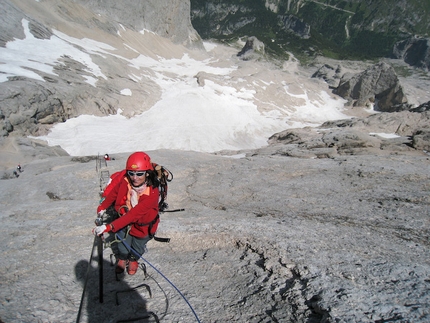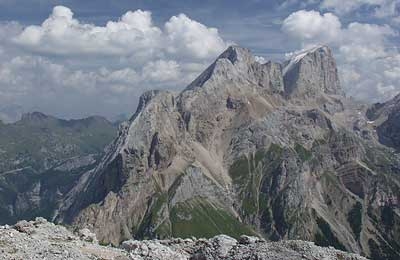
 1 / 6
1 / 6
Via Ferrata delle Trincee
 Planetmountain
Planetmountain
Beauty





By
Planetmountain.com
Orientation
West - East
Ascent height difference
300m
Ferrata height difference
200m
Height
2727m
Difficulty
Medium
Time
2 hours
Period
June to October
Popularity
High
The Ferrata delle Trincee is an interesting itinerary, not only from a physical and naturalistic point of view, but also because it crosses through narrow clefts and tunnels that date back to the First World War, inducing the walker to interpret and reflect upon this violent past.
Getting there
From Val di Fassa or Malga Ciapela drive up to Passo Fedaia and leave the car at the dam. Take path no. 698 to Porta Vescovo and the start of the ferrata. Alternatively, from Arabba take the cable car directly to Porta Vescovo. Access
From Passo Fedaia take path no. 698 for about 45 mins to reach Rif. Porta Vescovo and the cable car that leads up from Arabba. Follow signs east and traverse towards the Mesola to then finish steeply directly beneath Bec da Mesdi. Itinerary
The ferrata begins up a smooth 30m slab. Climb up this to a good ledge that leads off leftwards to a further set of less steep slabs. Continue up these and on to the summit crest. The itinerary now alternates on both sides of the ridge, at times exposed but well-equipped, and on to a small bridge. Reach the Mesola summit and descend steeply to a wide saddle. Either leave the ferrata at this point by following the path south meet up with those that lead to the cable car, or proceed along the ridge. This leads through two tunnels onto the north and south face of the Mesola. The path is exposed and reaches the final steep Mesolina incline. Use the cables to climb up to the last tunnel; walk through this taking care not to chose the wrong fork and after about 300m exit onto the SE face, close to Bivacco Bontadini 2550m. Descent
From the bivouac take the path east rapidly down to Rif. Padon 2390m and descend along the piste south (path no. 699) to Passo Fedaia and the dam. To return to Arabba take path no. 699 north or, alternatively, the path that traverses across the south face back to Porta Vescovo Gear
Torch necessary. Maps/Bibliography
Via Ferratas of the Italian Dolomites: Vol 1 by John Smith and Graham Fletcher . Cicerone Press 2002 Difficulty
The itinerary is technically varied and nice. The most difficult section is to be found right at the start: a steep smooth slab. Good hiking boots make a world of difference on this volcanic rock.
From Val di Fassa or Malga Ciapela drive up to Passo Fedaia and leave the car at the dam. Take path no. 698 to Porta Vescovo and the start of the ferrata. Alternatively, from Arabba take the cable car directly to Porta Vescovo. Access
From Passo Fedaia take path no. 698 for about 45 mins to reach Rif. Porta Vescovo and the cable car that leads up from Arabba. Follow signs east and traverse towards the Mesola to then finish steeply directly beneath Bec da Mesdi. Itinerary
The ferrata begins up a smooth 30m slab. Climb up this to a good ledge that leads off leftwards to a further set of less steep slabs. Continue up these and on to the summit crest. The itinerary now alternates on both sides of the ridge, at times exposed but well-equipped, and on to a small bridge. Reach the Mesola summit and descend steeply to a wide saddle. Either leave the ferrata at this point by following the path south meet up with those that lead to the cable car, or proceed along the ridge. This leads through two tunnels onto the north and south face of the Mesola. The path is exposed and reaches the final steep Mesolina incline. Use the cables to climb up to the last tunnel; walk through this taking care not to chose the wrong fork and after about 300m exit onto the SE face, close to Bivacco Bontadini 2550m. Descent
From the bivouac take the path east rapidly down to Rif. Padon 2390m and descend along the piste south (path no. 699) to Passo Fedaia and the dam. To return to Arabba take path no. 699 north or, alternatively, the path that traverses across the south face back to Porta Vescovo Gear
Torch necessary. Maps/Bibliography
Via Ferratas of the Italian Dolomites: Vol 1 by John Smith and Graham Fletcher . Cicerone Press 2002 Difficulty
The itinerary is technically varied and nice. The most difficult section is to be found right at the start: a steep smooth slab. Good hiking boots make a world of difference on this volcanic rock.
 Comments
Comments
29/08/2008 Andrea Belardi
Bellissima ferrata.La sconsiglio a chi,come me,è alla primissima esperienza.Questo a causa dell'impressionante parete iniziale e della notevole esposizione. In ogni caso il percorso è tutto percorribile in sicurezza grazie al cavo. La vista offre un panorama a 360 gradi ed è sicuramente molto interessante e suggestivo il passaggio nelle gallerie e nei resti delle trincee della prima guerra mondiale.
29/08/2008 Sandro Cremona
Molto bella, non ho trovato le indicazioni per l'ingresso della galleria (in diversi non l'abbiamo trovata e siamo scesi per i prati)
29/08/2008 Sandro Cremona
Aggiunta: Anche la descrizione nel presente sito non fornisce indicazioni chiare per trovare l'ingresso della galleria. Mancando queste, sia sulla via sia sul sito, si perde una delle bellezze della ferrata e si è costretti a scendere a valle attraversando i prati.
12/08/2008 simone nale
fantastica ferrata!l'attacco e' veramente duro ma poi ci si diverte una cifra! da rifare!!!
Beauty





By
Planetmountain.com
Orientation
West - East
Ascent height difference
300m
Ferrata height difference
200m
Height
2727m
Difficulty
Medium
Time
2 hours
Period
June to October
Popularity
High
Routes in the same mountain group



 Copia link
Copia link Planetmountain.com
Planetmountain.com



